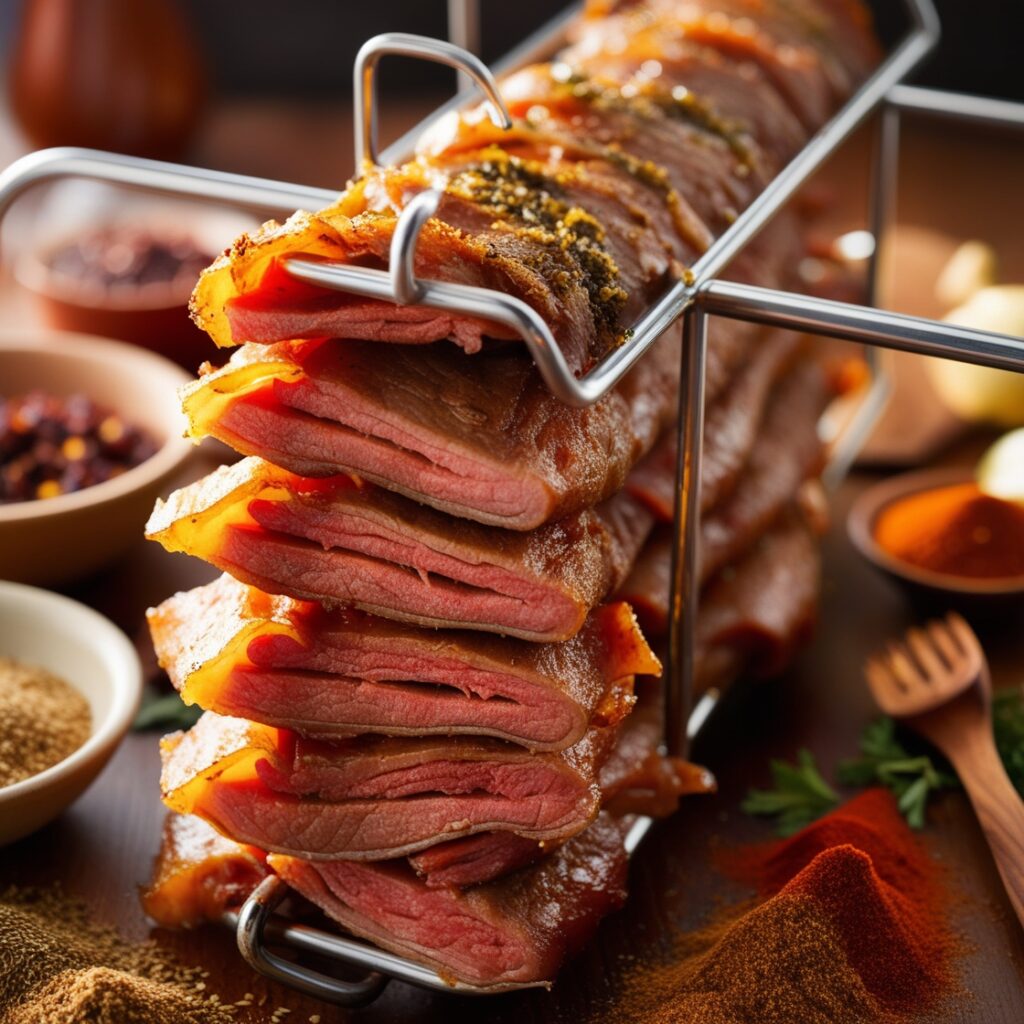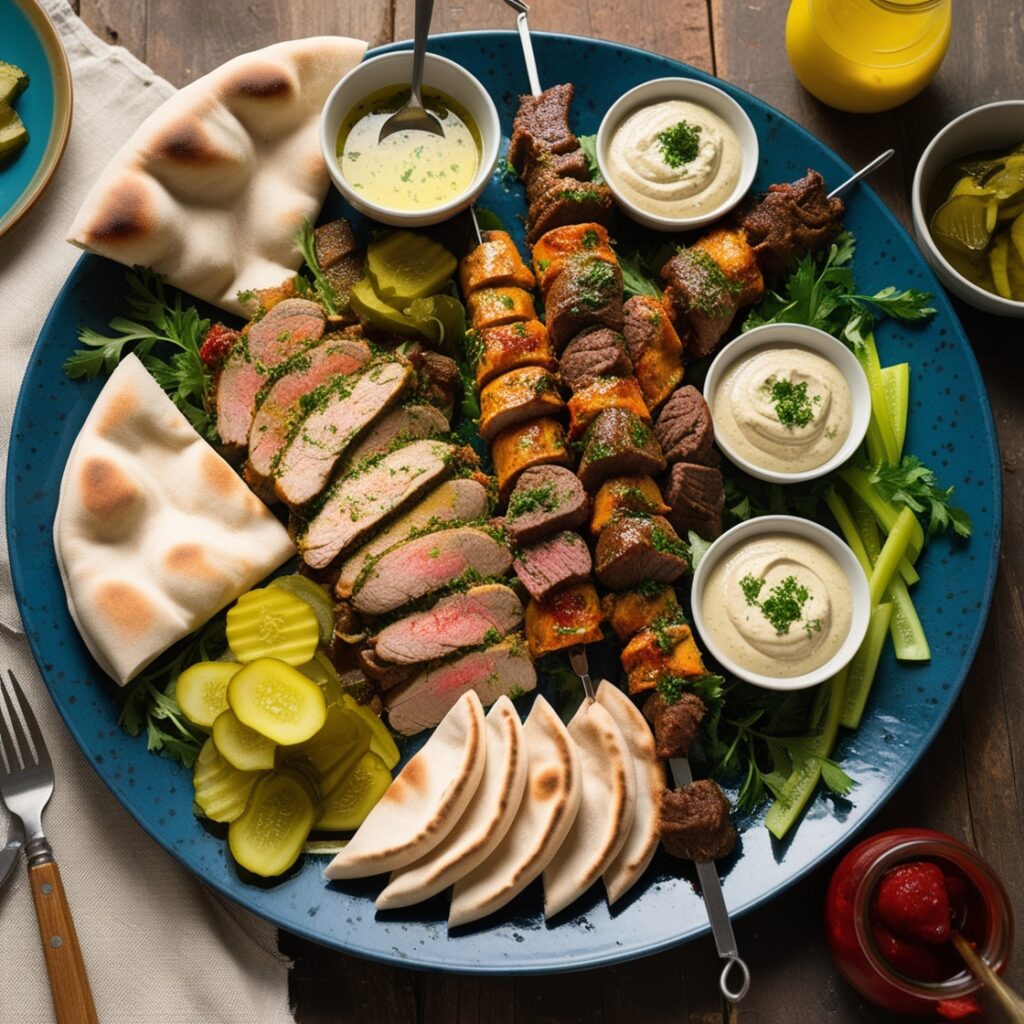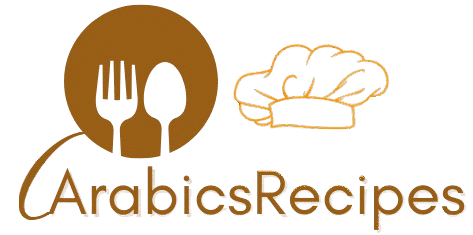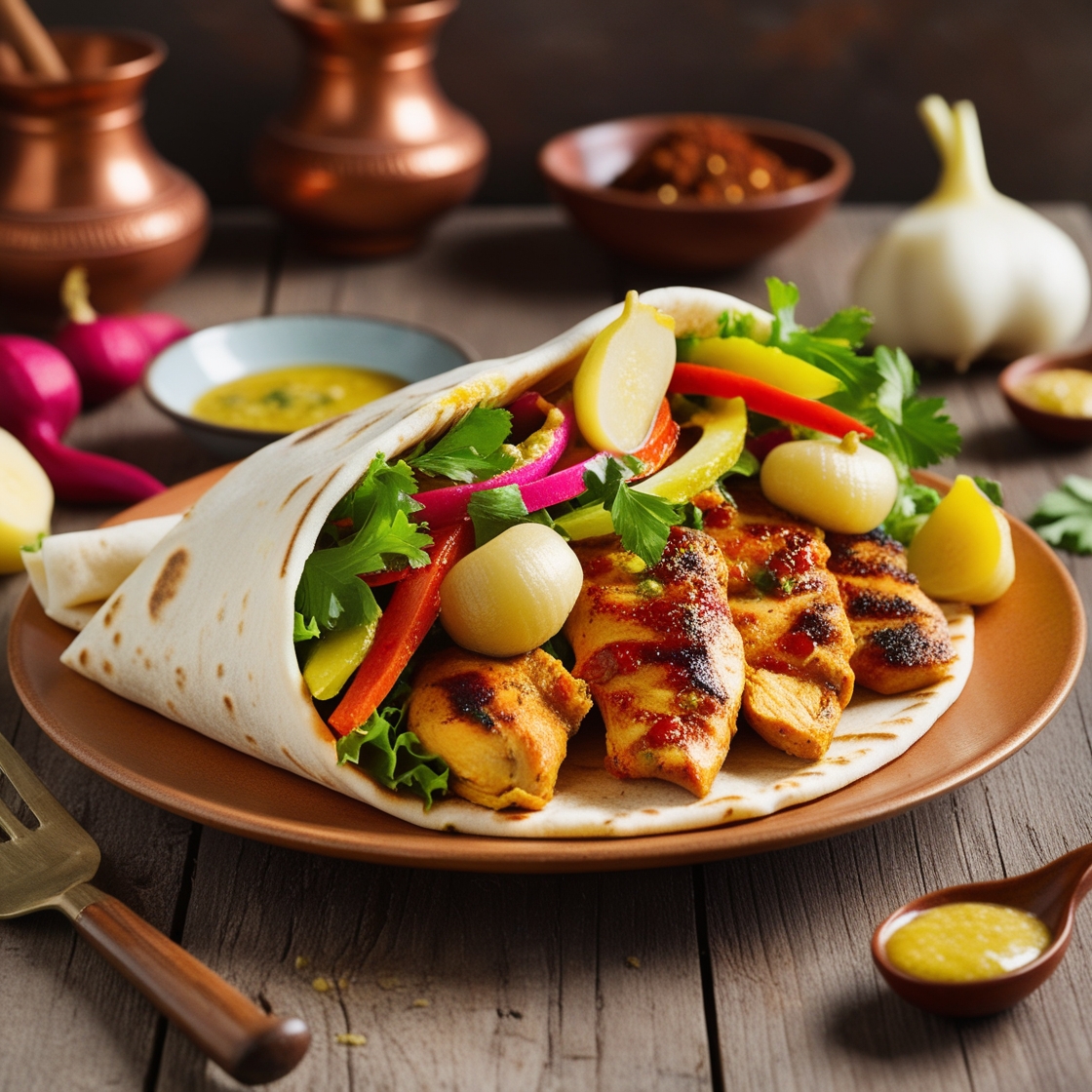Shawarma is more than just a meal—it’s a journey into the heart of Middle Eastern cuisine. From its aromatic spices to its tender, juicy meats, this dish has won hearts worldwide. But what exactly goes into making shawarma so special? In this guide, we’ll unravel its ingredients, explore the traditional cooking methods, and dive into its regional variations. Whether you’re a foodie, a curious cook, or just someone who loves a good wrap, this article will answer your burning question: What is shawarma made of?
Introduction to Shawarma
What is Shawarma?
Shawarma is a savory, spiced meat dish that hails from the Middle East. It’s traditionally cooked on a vertical rotisserie, where layers of marinated meat—typically chicken, lamb, or beef—are stacked and slowly roasted to perfection. The cooked meat is shaved off in thin slices, usually served in a flatbread wrap or over rice, accompanied by an array of sauces and toppings.
This dish isn’t just food; it’s a cultural experience. Shawarma embodies the rich culinary traditions of its origin, combining bold flavors and unique cooking techniques that have evolved over centuries.
Origin and History of Shawarma
The roots of shawarma can be traced back to the Ottoman Empire, where a similar dish called doner kebab was popular. The name “shawarma” itself comes from the Arabic word shawarim, meaning “turning,” a nod to the rotating spit used in its preparation.
Over time, shawarma spread across the Middle East and beyond, adapting to local tastes and ingredients. Today, it’s a global street food phenomenon, beloved for its versatility and mouthwatering flavors.
The Core Ingredients of Shawarma
Primary Proteins: Meat Choices
When it comes to answering what is shawarma made of, the first ingredient that comes to mind is meat. Traditionally, shawarma is crafted using lamb, beef, or chicken. Each type of meat brings its own distinct flavor profile. Lamb and beef offer a rich, hearty taste, while chicken is a lighter option that absorbs marinades beautifully.
Regional variations also play a significant role. In the Middle East, lamb is a favorite, while chicken shawarma dominates in countries like Lebanon and Egypt. These meats are often carefully selected for their tenderness, ensuring they remain juicy even after hours of slow roasting.
For a detailed recipe on chicken shawarma preparation, check out this Middle Eastern Delight: Chicken Shawarma.
Marinades and Spices Used
The magic of shawarma lies in its marinade. A mix of yogurt or vinegar, olive oil, and a symphony of spices like cumin, coriander, paprika, and turmeric infuses the meat with bold flavors. These spices not only enhance taste but also tenderize the meat, ensuring it’s succulent with every bite.
One key ingredient is sumac, which adds a tangy twist. Garlic, a staple in Middle Eastern cuisine, is another essential, lending its aromatic punch to the marinade. This harmonious blend is what sets shawarma apart from other meat dishes.
Cooking Techniques
Traditional Vertical Rotisserie Method

The hallmark of authentic shawarma preparation is the vertical rotisserie. Layers of marinated meat are stacked on a skewer, often topped with a piece of fat to keep it moist during cooking. As the rotisserie rotates, the outer layer of meat roasts to perfection, achieving a crispy exterior while the inside remains tender and juicy.
The meat is then shaved off in thin slices, ensuring every piece is perfectly cooked. This method not only enhances flavor but also creates the iconic texture of shawarma.
Modern Adaptations and Variations
In home kitchens and smaller establishments, modern methods like grilling or oven-roasting are used as substitutes for the vertical rotisserie. While these methods lack the traditional smoky flavor, they still deliver a deliciously satisfying dish.
For those looking to recreate this dish at home, consider this Shawarma Recipe Guide for step-by-step instructions.
Accompaniments and Serving Styles
Wraps and Bread Options

Shawarma is as much about the bread as it is about the meat. Traditionally, it’s served in soft, pliable pita bread that perfectly encases the tender slices of meat, sauces, and toppings. Flatbreads like lavash are also popular, especially in regions where they’re a staple.
For a heartier option, shawarma can be served on a plate alongside rice or salad. This variation is ideal for those who prefer to enjoy the dish without bread. Whether wrapped or plated, the bread serves as a canvas for the dish’s rich flavors.
Popular Sauces and Condiments
No shawarma is complete without its signature sauces and condiments. Garlic sauce (known as toum) is a must-have, offering a creamy, tangy flavor that complements the spices in the meat. Other common options include tahini sauce, made from sesame seeds, and spicy chili sauces for those who like a kick.
Pickled vegetables, such as turnips and cucumbers, add a zesty crunch, while fresh veggies like lettuce, tomatoes, and onions provide a refreshing balance. These accompaniments not only enhance the flavor but also add texture, making every bite exciting.
For more recipes featuring authentic sauces and condiments, check out Middle Eastern Delight: Chicken Shawarma.
Regional Variations of Shawarma
Middle Eastern Shawarma
In the Middle East, shawarma is a culinary staple with deep cultural roots. Countries like Lebanon, Syria, and Jordan are known for their unique takes on the dish. For instance, Lebanese shawarma often features a stronger garlic flavor, while Syrian versions might include a hint of cinnamon for added warmth.
The meat is usually paired with traditional sides like tabbouleh, hummus, or baba ghanoush, creating a wholesome meal that’s as satisfying as it is flavorful.
Western and Global Adaptations
As shawarma gained popularity worldwide, it adapted to local tastes. In the West, it’s often served with fries or coleslaw, and some versions include melted cheese for a fusion twist. Vegetarian and vegan options have also emerged, featuring marinated tofu or seitan as a substitute for meat.
These adaptations reflect the versatility of shawarma and its ability to cater to diverse palates while retaining its essence.
Health Aspects of Shawarma
Nutritional Benefits
Shawarma, when prepared with fresh ingredients, can be a nutritious meal. The key proteins—chicken, lamb, or beef—are excellent sources of protein, essential for muscle growth and repair. Additionally, the spices used in shawarma, such as turmeric and cumin, are known for their anti-inflammatory properties.
The vegetables and pickled accompaniments add fiber, vitamins, and minerals to the dish, making it a well-rounded meal. When served with whole-grain pita or flatbread, shawarma becomes a wholesome option that satisfies both taste and nutritional needs.
Potential Health Concerns
However, not all shawarma is created equal. Some versions may contain high levels of saturated fat, especially when fatty cuts of meat are used or when the dish is paired with heavy sauces. Additionally, excessive sodium from pickled veggies and marinades can be a concern for those watching their salt intake.
To enjoy shawarma healthily, opt for lean cuts of meat, go easy on the sauces, and choose whole-grain bread when possible. This balance ensures you can savor the flavors without compromising your health.
FAQs About Shawarma
Where Does Shawarma Come From?
Shawarma originates from the Middle East, specifically from the Levant region, which includes countries like Lebanon, Syria, and Jordan. Its name comes from the Arabic word shawarim, meaning “turning,” referring to the rotating spit used to cook the meat.
What is Shawarma & How Does It Work?
Shawarma is a dish made of thinly sliced meat, marinated in a blend of spices, and cooked on a vertical rotisserie. The slow rotation ensures even cooking, while the marinade infuses the meat with its signature flavor. The cooked meat is shaved off and served in wraps, on plates, or with rice.
Where is Shawarma Made?
Shawarma is made in restaurants, street food stalls, and home kitchens worldwide. Its popularity has spread far beyond the Middle East, making it a global favorite. In traditional settings, it’s cooked on a vertical spit, but at home, grilled or oven-roasted methods are common.
Is Shawarma the Same as Gyro?
While shawarma and gyro share similarities, such as being cooked on a rotisserie and served in wraps, they differ in flavors and origins. Shawarma is Middle Eastern and uses a variety of spices, while gyro is Greek and typically features oregano and other Mediterranean herbs.
Conclusion and Final Thoughts
Shawarma isn’t just a dish; it’s a celebration of flavor, culture, and history. From its tender, marinated meats to its array of vibrant accompaniments, shawarma embodies the richness of Middle Eastern cuisine. By now, you know the answer to what is shawarma made of—a perfect combination of carefully chosen proteins, aromatic spices, and complementary sauces and sides.
Whether you’re enjoying it in a traditional pita wrap, on a plate with rice, or even as part of a modern fusion dish, shawarma offers something for everyone. It’s no wonder this dish has captured hearts and taste buds across the globe.
FAQs and Additional Resources
FAQs Recap
To wrap up, let’s revisit some of the most common questions about shawarma:
- Where does shawarma come from? It originates from the Levant region in the Middle East.
- What is shawarma made of? It’s primarily made of marinated meats like chicken, lamb, or beef, cooked on a vertical rotisserie.
- Where is shawarma made? You’ll find it everywhere—from street food stalls to high-end restaurants worldwide.
- Is shawarma the same as gyro? While they share similarities, shawarma is Middle Eastern, and gyro is Greek, with distinct flavors and preparation styles.
Additional Resources
If you’re inspired to try making shawarma at home, check out this Shawarma Recipe Guide for step-by-step instructions. For more culinary inspiration, explore recipes like Middle Eastern Delight: Chicken Shawarma and other delicious dishes from the region.

